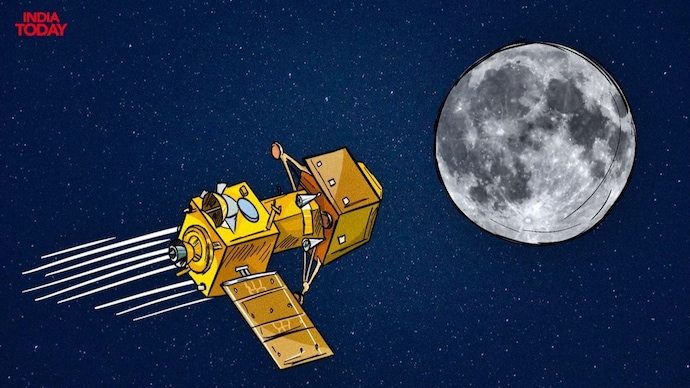Isro to insert Chandrayaan-3 in orbit around moon shortly
Chandrayaan-3's primary objective is to demonstrate a safe and soft landing on the lunar surface and operate a rover for approximately one lunar day, or 14 Earth days.

In Short
- it was launched on July 14 from the Satish Dhawan Space Centre
- Chandrayaan-3's primary objective is to demonstrate safe and soft landing
- The mission is a stepping stone towards ISRO's future interplanetary missions
By India Today Science Desk: India's third lunar mission, Chandrayaan-3, is set to make a significant maneuver in its journey today. The spacecraft is scheduled to enter the lunar orbit at 7 pm, marking a crucial phase in this ambitious mission.
Launched on July 14, 2023, from the Satish Dhawan Space Centre in Sriharikota, Chandrayaan-3 has been on a steady course towards the moon.
The Lunar Orbit Insertion (LOI), planned for today, will see the spacecraft embedded in an orbit around the moon, a maneuver that will be performed from ISRO Telemetry, Tracking and Command Network (ISTRAC) in Bengaluru.
Chandrayaan-3's primary objective is to demonstrate a safe and soft landing on the lunar surface and operate a rover for approximately one lunar day, or 14 Earth days.
FOLLOW CHANDRAYAAN-3 LIVE UPDATES HERE
The rover, weighing just 26 kilograms, is equipped with scientific instruments including cameras, spectrometers, and a drill to study the lunar surface.
The mission is a stepping stone towards ISRO's future interplanetary missions, demonstrating crucial capabilities and paving the way for further exploration of our celestial neighbors.
The spacecraft is expected to land near the lunar south pole region on August 23, 2023, at 5.47 pm.

The Chandrayaan-3 mission follows Chandrayaan-2, which encountered a last-minute glitch in the landing guidance software leading to the lander crashing after entering lunar orbit. Learning from the past experience, ISRO has made significant improvements in the design and technology of Chandrayaan-3.
The lander for Chandrayaan-3 is equipped with a Laser Doppler Velocimeter (LDV) and stronger impact legs compared to its predecessor. The rover, designed with six wheels, has a range of 500 meters and is expected to make important scientific discoveries about the composition of the lunar surface.
The mission also carries the Spectro-polarimetry of Habitable Planet Earth (SHAPE) payload on the Propulsion Module to study the spectral and polarimetric measurements of Earth from the lunar orbit.
As the nation awaits the successful lunar orbit insertion of Chandrayaan-3, the mission continues to symbolise India's growing prowess in space exploration and its commitment to unraveling the mysteries of the cosmos.

